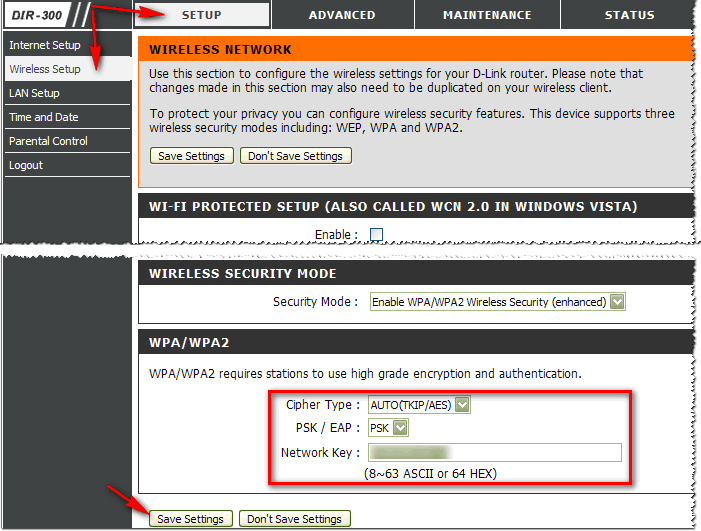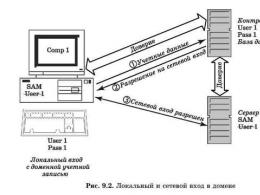How to set a new wifi password. How to password-protect Wi-Fi? Detailed instructions
Good day!
“Why does my Internet slow down every evening, I can’t download anything, and pages open for a long time?” one friend asked me...
The next day, after reviewing his Internet settings, programs, router, etc., only one thing surprised me: his home Wi-Fi network was not password protected. (it just didn't exist).
Oddly enough, by setting a password, the brakes and lags of the Internet stopped, and in the evening the Internet began to work as expected. Apparently, there were some neighbors who successfully used his Internet channel (and in the evenings, just everyone comes from work / from school, etc.).
In general, I will give one piece of advice: in any case, if you have any suspicions, change your password WiFi networks. If you don't have it at all - be sure to install it!
👉 Important! You also need to change your Wi-Fi password because those who connect to your network will use the Internet under yours. In principle, if they watch some "seals" - then God bless him ...
But just imagine, if they commit illegal acts - the first person they come to will be you (most likely)! I think that no one needs such visits? Therefore, the PASSWORD is required!
To change the password for accessing a Wi-Fi network, you need to do something like this:
- go to ;
- then open a tab/section for settings wireless network (also called as " Wireless" or "Wi-Fi" ;
- in this tab select certificate of safety , encryption type , And password to access the network.
In general, everything is quite simple. Before proceeding to specific models routers and their configuration, I will focus on a few important parameters(voiced above).
Certificate of safety
The most popular security certificates that are in almost every router are: WEP, WPA-PSK and WPA2-PSK. To date better security provides a WPA2-PSK certificate, which is what I recommend choosing.
If devices that do not support WPA2-PSK will connect to the Wi-Fi network, then stop at the WPA-PSK option (some routers have WPA/WPA2-mixed mode).
By the way, some budget router models may not work stably and break the connection when WPA2-PSK is selected. In this case, try to limit the speed of work in the router, as well as change the security certificate.
Encryption type
Closely related to the security certificate. If you choose WPA, the Temporary Key Integrity Protocol (TKIP) is used, if you use WPA2, the secure AES standard is used.
Password selection
Here, perhaps, I will only say the most basic thing that I think about his choice. I noticed that many users put very simple passwords, like: "11111111", "2222222", "11111122222", etc. Such passwords are very quickly selected and cracked!
It is unlikely, of course, that someone will deliberately and for a long time guess the password to your home wifi networks (especially since the vast majority of them do not contain any valuable data), and nevertheless I will give a couple of tips on what the password should be:
- at least 8 characters;
- It is desirable to use both letters (Latin) and numbers (of course, some will also say special characters - but in my opinion it’s not worth it, it’s too dreary to type them on your phone or tablet when connected to the network);
- do not use your names, standard words (password, admin, computer, etc.), the most famous dates, etc.
Now let's move on to specific models of routers. So...
👉 To help!
You may need an article on how to enter the router settings -
D-Link
One of the most popular brands of routers in our country. There are enough of them a large number of models, but firmware that differ from each other (at the root) - not so much, 3-4 pcs. In this article I will give several variations of them, and first a few important parameters.
👉 IP Address(default) to enter settings: http://192.168.0.1
(preferably use Internet browser explorer)
Login(default): admin
Password(default): either an empty string, or the same admin.
In older router models (such as DIR-300, DIR-320, DIR-615, DIR-651), as a rule, the firmware is not translated into Russian and is presented in such an orange-gray design. To change the password, you need to go to the router settings (if you can't log in), and open section "Setup/Wireless setup".
At the bottom of the window in the column Network Key enter your password (see the screen below), by the way, they also set security certificate, and encryption type.. After the entered settings, save them - button Save settings.

DIR-300 - setup password / Setup/Wireless setup
By the way, there is a similar firmware in Russian translation, it is configured in the same way.
For router models DIR-300 NRU and DIR-320 NRU (firmware version 1.2) the settings page looks a bit different: nice White background, on the left side all the main settings sections are presented. We open "Wi-Fi/Security Settings" , and install:
- network authentication: WPA-PSK (for example);
- PSK encryption key: this is your password;
- WPA encryption: TKIP+AES.

DIR-300 NRU / firmware version 1.2
For D-Link DIR-620/DIR-320 NRU routers in firmware versions 1.3 and 1.4, the interface is somewhat different: when you go to main screen, you see a gray background and tiles (as in Windows 8) that display the main settings sections.
To change the password, you need to open the "Wi-Fi / Security Settings" section (number 1 on the screen below), and then enter:
- network authentication: WPA2-PSK (for example);
- Encryption key - enter a password;
- WPA encryption - AES (see screenshot below).

DIR-300 NRU 1.4 / password setting
Router from Rostelecom (Sagemcom)
In general, with routers from Rostelecom, as a rule, big problems does not occur - everything works as expected. Yes, and when you connect the Internet, you will be given a password and everything will be set up. The firmware in routers is completely in Russian, so there are usually no questions about it.
👉Parameters to enter settings
The address: http://192.168.1.1/
Password and login(default) : admin
Browser almost anyone will do: Opera, Firefox, IE, Chrome, etc.
To set a password, open the section "WLAN Setup/Security" . Further in the subsection "Manual setting access points" select:
- Authentication - WPA2-PSK;
- WPA/WAPI password - specify your password;
- Encryption WPA/WAPI - AES;
- next click the button "Apply/Save" (screenshot below).
Actually, that's the whole setup ...

TP Link
One of the largest manufacturers of routers, tens of millions of people around the world use their products. In our country, their routers are also very popular, and they cope very well with Russian "realities" (work with almost all Internet providers).
👉 Parameters to enter
IP address: 192.168.1.1 (on rare occasions 192.168.0.1 , depending on firmware version);
Username:admin;
Password: admin (type without dots, commas, etc.).
Most often you have to deal with the so-called "green" firmware. It is found in routers: TP-LINK TL-WR740xx, TL-WR741xx, TL-WR841xx, TL-WR1043ND(45ND), etc. Approximately 50/50 firmware is in English / Russian.
The screenshot below shows the English version: to change the password, you need to open the section "Wireless/Wireless Security" , then select WPA/WPA2-Personal and put:
- Version - Automatic (Recommended);
- Encryption - Automatic (Recommended);
- enter the password on the line PSK Password .

TP-Link ("green" firmware)
Almost identical actions will need to be done in the Russian version of the "green" firmware: open the section "Wireless Security" , then set PSK password(see number 3 on the screen below).

TP-Link "green" firmware (Russian version)
Also quite often you can find the "blue" version firmware in TP-Link routers (for example, TP-LINK WR340G, TP-LINK WR340GB and other similar models).
Their setup is almost identical:
- first open section "Wireless Settings" ;
- in the column Security Type install WPA-PSk/WPA2-PSK;
- Security Option- set Automatic;
- Encryption- install Automatic;
- PSK Passphrase- this is the password (somewhat different spelling than in other firmware versions). It must then be specified wireless connection to the router.

TP-Link "blue" firmware
After the settings have been made, save them (button Save on the screen above, see number 3).
TRENDnet
The access parameters are relevant provided that the router has factory settings and its IP has not changed.
👉 IP address to enter settings: http://192.168.10.1
User Name (login): admin
Password (access password): admin
In general, TRENDnet routers most often have 2 firmware versions: blue and gray (both in Russian and English).
To configure security and set a password in the "blue" firmware, for example, the TRENDnet TEW-432 BRP router, you must do the following:
- open section Wireless/Security ;
- in field Authentication Type select WPA;
- in field PSK/EAP select PSK;
- in field Cipher Type select Auto;
- in field Passphrase and Confirmed Passphrase enter your password and click apply(screen below).

TRENDnet TEW-432BRP / Security / Wi-Fi network security setup
In the "gray" version of the firmware (for example, as in the TRENDnet TEW-651BR router), the actions are performed in a similar way, even the menu items are located in the same places.

ASUS
👉 Parameters to enter
IP address(web interface) : 192.168.1.1
Login and password: "admin" (enter without quotes!)
Browser: preferably IE (although modern versions of the web interface work well with all popular versions Firefox browsers, Chrome, Opera, etc.).
Most often, ASUS routers have two firmware: "blue" and "black" (moreover, they usually come localized in Russian).
To change the password in ASUS RT-N10E, RT-N10LX, RT-N12E, RT-N12LX routers, etc. (this is with "blue" firmware), you need to open the section « Additional settings/Wireless network/General tab" .
In the graph "WPA preshared key" enter your password and save the settings.

ASUS / "blue" firmware
In ASUS RT-N10P, RT-N11P, RT-N12, RT-N15U, RT-N18U routers, the firmware (in terms of setting the password) differs only in color. It also needs to open a section "Wireless network" , tab "General". Then change the column "WPA Preshared Key", and save your settings.

ASUS / "black" firmware version
Zyxel
👉 Parameters to enter
IP addressrouter on the network (web interface): 192.168.1.1
Login: admin
Password(default): admin
👉 Help!
To change the password on the ZyXEL Keenetic of the first series, you need to go to the web interface, open the section "Wi-Fi network", tab "Security" . Next, set the following parameters:
- Authentication- WPA-PSK/WPA2-PSK;
- Type of protection- TKIP/AES;
- Network key format- ASCII;
- Network key (ASCII)- set your password, which then will need to be specified when connecting wirelessly to the router.

In newer routers ( for example, Zyxel Keenetic II: Start, Giga, Omni, Viva, Extra) installed a different firmware. To change the password in them, you need to select the section in the menu "wi-fi" and then select the tab (top) - "Access point" .

NetGear
👉Parameters to enter
IP address(to enter the router settings): 192.168.1.1
Login: admin
Password(default): password
You can use almost any browser: for example, Internet Explorer, Mozilla Firefox, Opera, Safari, etc.
To change the password on NETGEAR routers (using model WNR2200 as an example): open section "Wi-Fi Setup" , then install:
- Security options: select item WPA-PSK (TKIP) + WPA2-PSK (AES) ;
- Passphrase: enter your password (it will later be necessary to specify it when connecting wirelessly to the router).

NETGEAR / Wi-Fi setup
Tenda
Recently, these routers have been quite popular. Even budget models provide a very good level of work, without failures and reboots (by the way, I had it on my blog).
👉Parameters
IP address: 192.168.0.1
Browser: Chrome, Opera, IE, Firefox
Firmware for most Tenda routers typical and similar to each other. In general, you need to open a section "Wireless Settings" ("Wireless Settings") and change the value in the string Wi-Fi Password ("wifi password"). An example is on the screen below.

In principle, in this short article I tried to consider all the most popular models routers. If you have a different model from the above, the technique will not change: first you need to find the IP address to enter the router settings (it can be found in the documents, on a sticker on the device case, or on the manufacturer's website) .
Then, entering the router settings, you need to open the Wi-Fi security section (or wifi settings) - then put the desired password and save the settings. Difficulties, most often, are a: either the password does not fit, or the IP address is incorrect, or something else ...
If you have something to add - strike at least a couple of words (thanks in advance).
Do not know how to set or change the password for accessing the wireless network on the router (router) Asus, D-link or TP-link?
So our guide is for you.
With it, you can set up safe use almost any SOHO class router (for home and small office) from the above manufacturers.
Asus
All wireless network settings are configured through the web interface or, as they say, the router's admin panel.
AsusTek equips routers consumer (home) segment with two types of interfaces (pictured above).
At first glance, they are quite different, but in fact there are few differences in them.
Having figured out how to put pass wi-fi on one Asus brand router, you can easily do it on another.
The web interface is accessed through a computer or other device (tablet, phone) connected to the router via a wired or wireless connection.
The standard network address of Asus routers is 192.168.1.1. This IP must be entered into address bar any browser and press Enter.
After that, you will open main page admin panel, similar to one of the pictures above.
To set or change the Wi-Fi password on the Asus router, do the following:
- Enter your username and password to access the admin panel. Virtually all Asus routers by default they are the same - "admin" and "admin". If this login / password pair does not suit you, refer to the documentation of the router, perhaps others are indicated there to enter.
In addition, the IP address, login and pass must be printed on a sticker affixed to the bottom of the instrument. - After logging into the admin panel, click the "Wireless" button in the panel on the left. The button is located in the "Advanced settings" section.

- In the wireless network configuration section, select the Authentication method from the drop-down list and enter any combination of Latin letters, numbers, and special characters in the WPA Preshared Key (WPA-PSK key) field.
This will be the password for accessing your Wi-Fi network. The most secure authentication method today is WPA2-personal. If you select it, the password must be at least 8 characters long.

- To save the settings, click the "Apply" button. Now outsiders will not be able to use your wireless network.
If, after setting or changing the password, any devices cannot connect to the Wi-Fi network, displaying messages that the saved settings do not meet the requirements of the network or simply "failed to connect", you need to go to the device's network settings and delete this network.
After rediscovery this network, you can easily connect to it by entering New password.
TP link
Setting up a wireless network on TP-link routers slightly different from how it is done on Asus routers.
The web interface is also accessed through the browser of any connected device (computer, phone, tablet) at tplinklogin.net or IP 192.168.0.1.
The default login and password for TP-link are the same as for Asus - “admin” and “admin”. And again, all this data is on the sticker, which is located on the bottom of the device.
Important! If you open the router's web interface at tplinklogin.net, first disconnect it from the Internet (you can simply temporarily disconnect the provider's cable).
Now let's figure out how to put a Wi-Fi password on a TP-link router:
- After logging into the admin panel, click on the "Wireless" button in the "Network" section of the main menu. Next, open "Wireless security".

- Check the box next to "WPA-PSK/WPA2-PSK (Recommended)". Select the desired authentication method from the list, WPA2-PSK is the best as the most secure. Leave the encryption type unchanged.
- In the "PSK password" (PSK key) field, enter 8-63 characters, including Latin letters, numbers and special characters (Cyrillic cannot be used). This will be the password for your Wi-Fi network.
- Save your settings. Your network is now secure.
To change already existing password Wi-Fi on the TP-link router, follow the same steps.
If the network connection is disconnected after setting the password, do what we wrote about above: go to the section network settings on the device where the disconnect occurred and delete that network.
After you see it again in the list available WiFi, connect by entering the SSID and the new password.
D-link
Having understood how to set wireless network passwords on Asus and TP-link routers, you can easily deal with D-link settings, despite a number of differences in the interface of the admin panels.
And in fact, there are very few differences in them: access to the admin panel is opened by IP or 192.168.1.1 (some models can be configured for one IP, others for another), the password and login are again “admin” and “admin” .
The same data, set by default, is printed on a sticker attached to the bottom of the router.
To set or change the Wi-Fi password on a D-link router, connect to it via a cable or wifi computer, tablet or phone, open a browser (D-link manufacturers recommend using Mozilla Firefox or Internet Explorer) and enter one of the above IP addresses into the address bar.
- After logging into the admin panel, open the "Wi-Fi" section through the main menu. Other variants of its names are "Wireless" or "Wireless setup" (in different versions D-link firmware admin looks different).

- Open "Security settings" (Wireless security).
- Select the WPA-PSK/WPA2-PSK security type from the "Authentication method" drop-down list.
- In the "PSK encryption key" (PSK key) field, enter the password for accessing the network. It must consist of 8-63 characters, including Latin letters, numbers and special characters. The Cyrillic alphabet cannot be used.
- Leave the encryption settings unchanged.
- After you have set the Wi-Fi password to D-link router, save the settings and exit the menu. To do this, click the "Change" button.

Now your Wi-Fi network is closed from access by unauthorized users.
If a device is having problems connecting to the network after setting a password, open the list network connections this unit and delete the network.
After re-discovery, you will be able to connect to it with a new password.
How to put a password on a Wi-Fi network
How to set a Wi-Fi password is a fairly common question that you need to know in order to secure your personal wireless network. This video clearly explains how to set a password for Wi-Fi, as well as how to change it in the access point settings.
 It often happens that you set up the Internet through a router, but forgot to put password on WIFI or failed due to inexperience. I propose to resolve this issue.
It often happens that you set up the Internet through a router, but forgot to put password on WIFI or failed due to inexperience. I propose to resolve this issue.
(very soon I will record a video lesson, but for now the text version)
First of all, be sure to connect the blue cable to your computer. It usually comes with a router and is used for configuration. Insert one end of the blue cable into the computer, and the other end into the router connector. It will turn out like this:


Now go to Start - Control Panel - Network and Internet - Network and Sharing Center and public access– Change adapter settings and make sure you have connected The local network. If not, then turn it on.


And now to the most important thing!
How to put a password on WIFI
First of all, we need. All changes are made through the web interface. Therefore, we launch or any other browser and prescribe the address 192.168.0.1. Depending on the router, the address may not be much different. You can view it at reverse side devices.

So, having registered the address in the browser, press Enter.

Before you set a password for WIFI, you need to log in.

Enter the username and password from the router itself. Usually the login is admin, and the password is either 12345678 or also admin. But the trick is that most often the person who changes this password for security purposes. Therefore, if the standard ones did not fit, then you need to find out the data from the original source, that is, from the master who set up the router for you.
After logging in, we will find ourselves in the settings. Depending on the router, the interface may differ, but the essence is the same everywhere. We need to find the WI-FI section and go to Security Settings.

Select WPA2-PSK authentication type and then a new field will appear: Encryption key where we can enter a password for WI-FI.
Many users who have recently installed wifi router are asking how to secure a WiFi network. In this post, we will analyze several techniques that will significantly complicate access to your network by unwanted users.
Now, in addition to a stationary computer, many have mobile devices that require an internet connection: laptops, smartphones, tablets. To connect these devices to the network, it is convenient to use your home Wi-Fi network.
But when you create a Wi-Fi network, there is a threat to the security of your data. Everything that is transmitted over a wireless network is broadcast over a fairly tangible distance and attackers can gain access to this data. To protect a WiFi network from such an attack, you need to take a few simple steps.
Quick navigation
Use a strong password to access your router settings
When setting up the router, of course, you must change default password. This does not follow the password path to access the router with a password (key) to connect to the network.
The web interface is usually available at http://192.168.1.1 or http://192.168.0.1
Use a strong security mode
Modern WiFi networks support multiple security modes. IN WiFi settings this item may be called "Security mode" or "Security mode".
For maximum WiFi network protection, you must use WPA or WPA2 (Wi-Fi Protected Access) mode.
Use a long and complex key to connect to the network
If the WiFi network is in WPA mode, you must enter a key to connect to it. In order for the WiFi network to be protected from hacking, the key (password) must be sufficiently long and complex.
The key must be at least 12 characters long and must contain letters and numbers. Do not use commonplace passwords, such as wi-fi, fi-wi, mywifi, etc.
Hide your SSID
Each WiFi has its own SSID ( WiFi name networks). If you enable SSID hiding in the router settings, you can connect to such a network only by knowing its name.
Of course, if you hide the SSID of your WiFi network, then it must be unique. In this case, it makes no sense to use banal phrases like “router” or “dlink” as an SSID. These names are easy to pick up.
Use MAC address filtering
Each network device has a unique MAC address. This feature makes it possible to restrict access to the network for unknown devices. In the router settings, you can specifically specify which MAC addresses are allowed to connect to the WiFi network.
MAC filtering is not a serious protection. But together with other methods, it significantly increases the protection of a WiFi network.
Video on how to set a password on WI-FI
What should I do if, after turning on the password on the Wi-Fi router, there is a limited connection and the router menu does not work?
Try resetting the router to factory settings by pressing the Reset button located on the back of the device. Set your password again.
Did you have a neighbor in the entrance who, without asking, connected to your Wi-Fi network? And you do not know how to put a new password on a Wi-Fi router. Then this article will be useful to you. After all, it often happens when they conduct the Internet, they immediately ask the master to set up the router. But, alas, the masters are different, some ask what password to put on Wi-Fi, others come up with it themselves, or even leave WiFi without a password. As a result, because of such negligence, you suffer. There are problems associated with low Internet speed. This is all due to a neighbor who has connected to your wireless network and is constantly downloading something. This problem in fact, it’s very easy to decide, you just need to know how to password-protect a Wi-Fi network in a new way, but how to do it, read further in the article.
First step. Go to the router settings menu
- In the lower right corner, click on the Wi-Fi icon. A window will open where you will see the available networks.
- Select your network, click " connect". A window will pop up asking you to enter new key. Put a check mark " Connect automatically».
Everything is ready, now the laptop will automatically connect to your wireless network. If there are gadgets for android, then a similar manipulation must be performed on all these devices.
Conclusion
When asked how to set a password on a Wi-Fi router, you read the answer in this article. In practice, everything is much easier, so you can safely proceed to setting a password. All questions that you have in the process of driving in the key, write below in the comments, we answer quickly.






